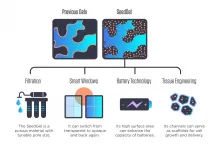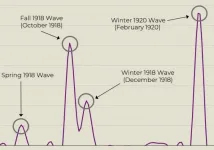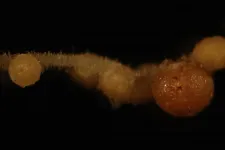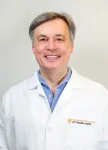Nanoparticle gel unites oil and water in manufacturing-friendly approach
Novel gel-creation method could open applications in water filtration, other applications
2021-02-10
(Press-News.org) Oil and water may not mix, but adding the right nanoparticles to the recipe can convert these two immiscible fluids into an exotic gel with uses ranging from batteries to water filters to tint-changing smart windows. A new approach to creating this unusual class of soft materials could carry them out of the laboratory and into the marketplace.
Scientists at the National Institute of Standards and Technology (NIST) and the University of Delaware have found what appears to be a better way to create these gels, which have been an area of intense research focus for more than a decade. Part of their potentially broad utility is the complex set of interconnected microscopic channels that form within them, creating a spongelike structure. These channels not only offer passageways for other materials to travel through, making them useful for filtration, but also give the gel a high amount of internal surface area, a characteristic valuable for speeding up chemical reactions or as scaffolding on which living tissue can grow.
While these and other advantages make it sound like gel innovators have struck oil, their creations have not yet mixed well with the marketplace. The gels are commonly formed of two liquid solvents mingled together. As with oil and water, these solvents do not mix well, but to prevent them from completely separating, researchers add custom-designed nanoparticles that can stay at the interface between them. Carefully cooking these ingredients allows a cohesive gel to form. However, the process is demanding because custom-designing nanoparticles for each application has been difficult, and forming the gels has required carefully controlled rapid temperature change. These constraints have made it hard to create this type of gel in any more than small quantities suitable for lab experiments rather than on an industrial scale.
As described in a new Nature Communications paper, the NIST/Delaware team has found ways to sidestep many of these problems. Its novel approach forms what the researchers refer to as a "SeedGel," an abbreviation for "solvent segregation driven gel." Instead of designing nanoparticles to remain at the interface between the two solvents, their chosen particles concentrate within one of them. While these particles tend to repel one another, the particles' affinity toward one of the solvents is stronger and keeps them together in the channel. Using neutron scattering tools at the NIST Center for Neutron Research (NCNR), the team unambiguously proved that it had succeeded at concentrating the nanoparticles where it wanted.
The resulting gel could be far easier to create, as its two solvents are essentially oil and water, and its nanoparticles are silicon dioxide -- essentially tiny spheres of common quartz. It also could have a variety of industrial uses.
"Our SeedGel has great mechanical strength, it's much easier to make, and the process is scalable to what manufacturers would need," said Yun Liu, who is both an NCNR scientist and an affiliated full professor at the University of Delaware. "Plus it's thermo-reversible."
This reversibility refers to an optical property that the finished SeedGel possesses: It can switch from transparent to opaque and back again, just by changing its temperature. This property could be harnessed in smart windows that sandwich a thin layer of the gel between two panes of glass.
"This optical property could make the SeedGel useful in other light-sensitive applications as well," said Yuyin Xi, a researcher from the University of Delaware also working at the NCNR. "They could be useful in sensors."
Because the team's gel-creation approach could be used with other solvent-and-nanoparticle combinations, it could become useful in filters for water purification and possibly other filtration processes depending on what type of nanoparticles are used.
Liu also said that the creation approach allows for the size of the channels within the gel to be tuned by changing the rate at which the temperature changes during the formation process, offering application designers another degree of freedom to explore.
"Ours is a generic approach working for many different nanoparticles and solvents," he said. "It greatly extends the applications of these sorts of gels."
INFORMATION:
[Attachments] See images for this press release:

ELSE PRESS RELEASES FROM THIS DATE:
2021-02-10
SAN ANTONIO -- Humans possess a formidable multi-layered defense system that protects us against viral infections. Better understanding of these defenses and the tricks that viruses use to evade them could open novel avenues for treating viral infections and possibly other diseases.
For example, a human protein called SAMHD1 impedes replication of the human immunodeficiency virus (HIV) and other viruses by depleting deoxynucleotides -- building blocks needed for the replication of the viral genome. It has long remained a mystery whether and how this protein is activated in response to infection.
Now researchers from The University of Texas Health Science Center at San Antonio (UT Health San Antonio) have discovered that SAMHD1 recognizes a unique molecular ...
2021-02-10
Sawfish have disappeared from half of the world's coastal waters and the distinctive shark-like rays face complete extinction due to overfishing, according to END ...
2021-02-10
EAST LANSING, Mich. - The 1918 influenza pandemic provides a cautionary tale for what the future may hold for COVID-19, says a Michigan State University researcher.
After a decade studying a flu virus that killed approximately 15,000 Michigan residents, Siddharth Chandra, a professor in MSU's James Madison College, saw his research come to life as he watched the spread of the COVID-19 pandemic.
"It was so surreal," said Chandra, who has a courtesy appointment in epidemiology and biostatistics. "All of a sudden, I was living my research."
Chandra's research is published in the American Journal of Public Health with co-authors Julia Christensen, a graduate of James Madison College; Madhur Chandra, Senior ...
2021-02-10
A team of astronomers, including associate professor Chad Trujillo of Northern Arizona University's Department of Astronomy and Planetary Science, have confirmed a planetoid that is almost four times farther from the Sun than Pluto, making it the most distant object ever observed in our solar system. The planetoid, which has been nicknamed "Farfarout," was first detected in 2018, and the team has now collected enough observations to pin down its orbit. The Minor Planet Center has now given it the official designation of 2018 AG37.
Farfarout's nickname distinguished it from the previous record holder "Farout," found by the same team of astronomers ...
2021-02-10
Orange, Calif. - The mutually beneficial relationship between legumes and rhizobia, the nitrogen-fixing soil bacteria that make their home in legume root nodules and create nutrient-rich fertilizer for them, is one of the most well-known and agronomically important examples of symbiosis. New research from END ...
2021-02-10
Individual choices in medicine carry a certain amount of uncertainty.
An innovative partnership at The University of Texas at Austin takes aim at medicine down to the individual level by applying state-of-the-art computation to medical care.
"Medicine in its essence is decision-making under uncertainty, decisions about tests and treatments," said Radek Bukowski, MD, PhD, professor and associate chair of Investigation and Discovery in the Department of Women's Health at Dell Medical School at UT Austin.
"The human body and the healthcare system are complex systems made of ...
2021-02-10
Firefighters and emergency medical services workers are at high risk of exposure to COVID-19 while on the job and pose an additional risk of transmitting the virus to others. Although vaccines are a promising public health tool for reducing COVID-19 transmission, little has been known about the perceptions of the COVID-19 vaccine among first responders.
To provide insight, a University of Miami Miller School of Medicine-led study queried a national sample of U.S. firefighters and emergency medical services workers through an anonymous online survey. The study results, published online Feb. 1 in the Journal of Occupational ...
2021-02-10
Ten years ago, researchers at Aarhus University, Denmark, reported the discovery of centimeter-long cable bacteria, that live by conducting an electric current from one end to the other. Now the researchers document that a few cells operate with extremely high oxygen consumption while the rest of the cells process food and grow without oxygen. An outstanding way of life.
We humans need food and oxygen to live.
Now, imagine if oxygen was to be found only at the mountain top and food only in the valley. That's how the world looks like for cable bacteria, which live in the bottom of seas and lakes. For them, ...
2021-02-10
In far too many cases over the years, scientists have discovered promising new cancer treatments, only to report later that the tumor cells found ways to become resistant. These disappointing results have made overcoming drug resistance a major goal in cancer research.
Now, experts at Cincinnati Children's report success at averting drug resistance in a subtype of brain tumors called glioblastomas. Importantly, the research indicates that the approach may also work in other cancers, such as melanoma, that exhibit a similar pathway of drug resistance.
The method involves inhibiting a protein called SCD and reducing the ...
2021-02-10
A potent ozone-depleting chemical whose emissions unexpectedly spiked in recent years has quickly dropped back to much lower levels, putting the recovery of the stratospheric ozone layer back on track, according to a new study by scientists at MIT, the University of Bristol, and other institutions in South Korea, the U.S., Japan, Australia, and Switzerland.
The chemical in question is CFC-11, a chlorofluorocarbon that was once commonly used for refrigeration, insulation, and other purposes. When emitted to the atmosphere, CFC-11 can loft into the stratosphere, where the sun's ultraviolet radiation breaks the chemical down to release chlorine -- a noxious chemical that then eats ...
LAST 30 PRESS RELEASES:
[Press-News.org] Nanoparticle gel unites oil and water in manufacturing-friendly approach
Novel gel-creation method could open applications in water filtration, other applications






